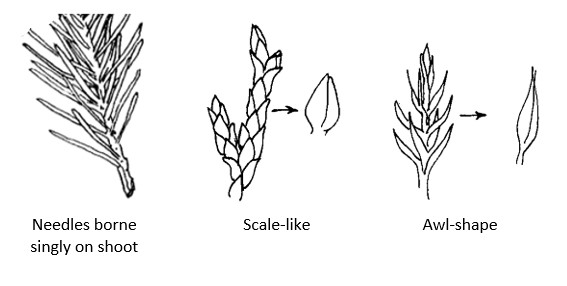Part 1 – Plant Identification
15 Plant Morphology – Conifers
Learning Objectives
- Use a dichotomous key to identify conifers.
Both evergreen and deciduous leaves exhibit characteristic broad blades in angiosperms, and narrow needle, scale-like, or awl-shaped leaves in the conifers. Figure 15.1 illustrates the different types of conifer leaves. Leaves may be borne singly on the shoot as in Picea spp. (spruce), in tufts or clusters as in Larix spp. (larch), or in fascicles (bundles) of 2-5 as in Pinus spp. (pines). The awl-shape and scale-like foliage of Juniperus spp. exhibits leaf dimorphism where a juvenile leaf form differs from the mature leaves of the same plant.

Dichotomous Key for Some Common Conifers.
View plant images at the KPU Plant Database.
-
- 1.a. leaves long, needle-like ……………………………………………….. go to 2
- 1.b. leaves lanceolate, awl or scale-like, overlapping, not needle-like ……………………………………………………………………………… go to 5
- 2.a. needles in bundles or tufts …………………………………………….. go to 3
- 2.b. needles borne singly …………………………………………………… go to 7
- 3.a. needles in bundles of 2 to 5 ……………………………………………. go to 4
- 3.b. needles deciduous, many in a tuft ……………….. Larix decidua
- 4.a. 5 needles per bundle ……………………………… Pinus strobus
- 4.b. 2 needles per bundle …………………………………………………. go to 10
- 5.a. scales imbricate (overlapping) cones small, upright… Thuja plicata
- 5.b. scales imbricate, cones spherical or oval, opening along sutures at maturity ………………………………………………………………………………. go to 6
- 6.a. cones small, spherical; cone scales with a prominent point ………………………………………………. Cupressus nootkatensis
- 6.b. cones larger, oval, cone scales thick, deeply pitted ………………………………………….. Sequoiadendron giganteum
- 7.a. needles stiff and sharp, 4-sided ………………………………………… go to 8
- 7.b. needles flat and pliable …………………………………………………. go to 9
- 8.a. needles extremely sharp, new growth coated with bluish wax…………………………………….. Picea pungens Glauca Group
- 8.b. needles not extremely sharp, not coated with bluish wax …………………………………………………………… Picea abies
- 9.a. needles dull green, 2 cm long, borne on short pegs that persist after the needles fall ……………………………………………….. Tsuga heterophylla
- 9.b. needles shining green, 2 cm long, not borne on pegs ……………………………………………….. Pseudotsuga menziesii
- 10.a. needles < 7 cm long ………………………………………………….. go to 11
- 10.b. needles > 7 cm long ………………………………. Pinus nigra
- 11.a. needles dark green, 3-6 cm long, cone scales with a small recurved prickle ……………………………………………………….. Pinus contorta
- 11.b. needles bluish green 5-7 cm long, slightly twisted, cone scales without a prickle ……………………………………………………… Pinus sylvestris

